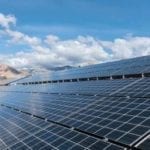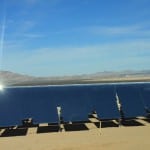Despite economic concerns, the U.S. solar industry saw a third straight year of record growth in 2008. The installation of 1,265 MW of all types of solar power last year brought total U.S. solar power capacity to 8,775 MW, an annual report from the Solar Energy Industries Association (SEIA) shows.
The report, “US Solar in Review 2008” (PDF), said that 342 MW of solar photovoltaic (PV), 139 MWth (thermal equivalent) of solar water heating, 762 MWth of pool heating, and an estimated 21 MW of solar space heating and cooling were installed in 2008.
Rates of growth also beat those in 2007. Grid-tied PV grew at a rate of 81%, to 292 MW in 2008, compared to 161 MW in 2007. Solar water heating installation grew at a 50% rate in 2008 (139 MWth) over 2007 (93 MWth), while pool heating growth slowed by 3% in 2008 (762 MWth) from 2007 (785 MWth).
In 2008, the U.S. solar industry also increased domestic PV manufacturing capacity by 65%, to 685 MW, creating desperately needed jobs in states such as California, Michigan, Ohio, Oregon, and Tennessee, the report said.
No new concentrating solar power plants came online in the U.S. in 2008, but projects in the offing add up to more than 6 GW, the report said. Among these are projects planned for California’s Mojave Desert, Arizona, and Florida.
States that led grid-tied PV installation were California (178.6 MW), New Jersey (22.5 MW), Colorado (21.6 MW), Nevada (13.9), and Hawaii (11.3 MW). For solar water heating systems, Hawaii led, installing 37% of all U.S. systems in 2008, followed by Florida (20%), California (7 %), Colorado (5%), and Arizona (5%).
Several states added or expanded incentives or requirements for solar energy, including California, Hawaii, Maryland, Massachusetts, Missouri, and Ohio. To date, 28 states have renewable portfolio standards that require a certain amount of energy be generated from renewable sources, with 19 of these states mandating that a portion come from solar or distributed sources.
A total of 42 states and the District of Columbia now have net metering rules allowing owners of solar energy systems to sell excess electricity back to the grid. However, these rules differ from state to state, and a unified national policy is necessary, the report found.
The Emergency Economic Stabilization Act of 2008 included an eight-year extension of the federal solar investment tax credit that has spurred U.S. market growth over the past three years, SEIA said. “This long-term extension will facilitate the long-term planning and investment necessary for the U.S. solar industry to reach its full potential.”
The organization said that the industry’s growth would be supported by provisions in the American Recovery and Reinvestment Act of 2009. These include a 30% grant program for commercial and utility-scale solar installations to be administered by the Department of Treasury, a Department of Energy loan guarantee program, and a 30% manufacturing investment tax credit to attract investors to the U.S. market. “Crafted wisely, other policies being debated at the national level—electric transmission infrastructure, national RPS, and global warming legislation—would also stimulate continued growth of the industry,” SEIA added.
Source: SEIA










